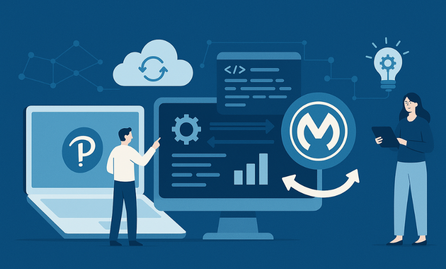Digital transformation enables businesses to reshape the customer experience and enhance operational efficiency. Among the most prominent technologies driving this transformation are Chatbots and AI Agents. While both are used to streamline customer interactions, accelerate response times, and reduce costs, they differ significantly in functionality and the benefits they offer. Today, many businesses make incorrect investments or move forward with incomplete strategies by not fully understanding the differences between these two technologies. So, what are the key differences between Chatbots and AI Agents? Which option is the best fit for your business? Let’s explore this topic in detail to determine the most suitable technology for your needs.
What is a Chatbot?
Chatbots are digital assistants that operate based on predefined rules and automatically respond to user inquiries. They typically function using keyword-based response systems or predetermined scripts. Businesses use chatbots to support customer service, answer frequently asked questions, and automate simple tasks.
Advantages of Chatbots
-
Fast and Instant Responses: Provides immediate replies to users without wait times.
-
Cost Efficiency: Reduces operational costs and lightens the workload on customer service teams.
-
Ideal for Simple Tasks: Efficiently handles routine tasks such as FAQs, order status inquiries, or booking processes.
-
Easy Integration: Can be integrated into platforms like WhatsApp, Facebook Messenger, website chat windows, and other digital channels.
Limitations of Chatbots
-
Limited Flexibility: Cannot go beyond predefined scripts and may respond inadequately to unexpected or complex queries.
-
Lack of Learning Capability: Cannot analyze user behavior or improve over time, limiting personalization in customer experience.
What is an AI Agent?
AI Agents are advanced digital assistants that use technologies such as natural language processing (NLP), machine learning, and big data analytics to deliver human-like interactions. They not only execute simple commands but also analyze user behavior, offer proactive suggestions, and provide effective solutions to complex issues.
Advantages of AI Agents
-
Smarter and More Comprehensive Responses: Understands user context to deliver more meaningful and personalized replies.
-
Learning Capability: Improves over time by learning from customer interactions, enabling better service delivery.
-
Omnichannel Support: Operates across various channels such as web, mobile apps, voice assistants, and social media platforms.
-
Operational Efficiency: Frees up human employees for more strategic tasks, boosting overall business efficiency.
Chatbot vs. AI Agents
While AI Agents represent the cutting edge of customer service technology, both chatbots and AI agents offer distinct advantages for enhancing customer experience and driving business success. The most suitable solution depends on your business’s specific needs. These tools excel in different areas:
Task Management
Chatbots are ideal for defined and repetitive tasks. They guide users effectively through simple, linear processes like password resets.
AI Agents, on the other hand, can manage both simple and complex customer requests. They understand deeper customer needs, offer personalized suggestions, and proactively serve users by analyzing past interactions. This flexibility makes AI agents a more comprehensive solution for delivering natural and intuitive customer experiences.
Communication Methods
Chatbots are typically limited to text-based communication, although some advanced models can recognize voice commands.
AI Agents support multichannel communication, operating across text, voice, and even visual interfaces. This variety allows customers to receive support via their preferred channel and makes AI’s natural language understanding more efficient.
Investment and Cost Comparison
Chatbots are more affordable initially as they operate on predefined scripts. If no advanced AI is required, most of the cost is upfront.
AI Agents offer greater functionality, handle a broader range of tasks, and reduce the need for human intervention. By providing more personalized and sophisticated customer service, they improve satisfaction and loyalty. Although they require higher investment, they offer greater long-term returns.
Data Security and Model Training
Chatbots are usually trained on existing platform data, such as CRM systems, to support customer service processes.
AI Agents can learn from large language models (LLMs) and extensive data sets, offering a broader and more sophisticated understanding by accessing data beyond the immediate platform.
Some AI Agents provide additional security layers to protect data and enable secure model training. However, businesses operating in regulated industries may prefer chatbot solutions to ensure that data remains entirely within the platform.
How to Choose the Right Option for Your Business
Choosing between chatbots and AI agents is not merely a technology decision—it reflects your customer experience strategy, operational needs, and vision for digital transformation. To make the right choice, focus on the following key evaluation areas:
-
Clarify the Purpose
-
Are your interaction scenarios focused on providing information, executing tasks, or personalizing experiences?
-
Is it sufficient to quickly answer basic queries, or is contextual understanding and proactive suggestions critical?
-
Analyze Budget and ROI
-
Chatbots offer a low-cost entry point and reduce operational load but provide limited flexibility.
-
AI Agents require a higher investment but deliver greater long-term returns through automation, customer satisfaction, and loyalty.
-
Assess Process Complexity
-
For low-complexity processes (e.g., order tracking, appointment scheduling), chatbot solutions may suffice.
-
For interactions involving customer profiles, transaction history, and multi-step workflows, AI Agents are more suitable.
-
Define Your Customer Experience Vision
-
Is your goal simply a responsive system, or a digital experience that understands and guides the customer?
-
AI Agents can enhance brand loyalty through personalization, contextual suggestions, and omnichannel engagement.
Beyond AI Agents: Introducing AgentForce
AI-powered agents are a major milestone in transforming the customer experience. However, businesses increasingly need systems that not only respond to interactions but also understand processes, take initiative, and drive outcomes. Positioned to meet this need, AgentForce represents the next stage in the evolution of AI agents.
AgentForce goes beyond traditional AI agents by combining Salesforce’s Einstein AI infrastructure, CRM capabilities, and workflow automation tools. It doesn’t just understand conversations—it interprets systemic context, initiates processes, and completes them. A single customer interaction can be turned by AgentForce into an opportunity, service request, campaign trigger, or automated workflow. In this sense, AgentForce is more than a digital assistant—it’s an AI-powered operational executor that drives efficiency across the enterprise.
Strategic Value of AgentForce
-
Contextual Decision-Making: AgentForce analyzes user history, transaction context, business rules, and system data to make intelligent decisions.
-
End-to-End Execution Capabilities: It doesn’t just respond—it triggers processes, launches tasks, and integrates with enterprise systems to deliver results.
-
Native Integration with Salesforce Ecosystem: Seamlessly works with CRM, Flow, Service Cloud, Slack, and other Salesforce tools to unify digital operations.
-
Proactive Operations Management: Leveraging data-driven insights, AgentForce becomes a proactive AI tool that acts first when necessary—not just reacts.
With these features, AgentForce surpasses the rule-based limits of chatbots and the reactive structure of traditional AI agents. It delivers tangible benefits not only in customer experience but also in operational agility, process automation, and integration of the digital workforce. It stands as a next-generation AI solution.
Chatbots, AI Agents, and next-generation solutions like AgentForce offer varying levels of value in the digitalization of customer interactions. Each has its strengths and limitations, and the right choice depends on your business goals, processes, and digital maturity. What matters most is designing a structure that not only enhances customer experience but also delivers long-term efficiency and agility.

 For Sales Automation
Sales Cloud
For Sales Automation
Sales Cloud
 For Customer Service Automation
Service Cloud
For Customer Service Automation
Service Cloud
 For B2C Marketing Automation
Marketing Cloud
For B2C Marketing Automation
Marketing Cloud
 For B2B Marketing Automation
Account Management
For B2B Marketing Automation
Account Management
 Discover the power of AI
Einstein AI
Discover the power of AI
Einstein AI
 Create a better shopping experience
Commerce Cloud
Create a better shopping experience
Commerce Cloud
 For Sales Automation
Sales Cloud
For Sales Automation
Sales Cloud
 For Customer Service Automation
Service Cloud
For Customer Service Automation
Service Cloud
 For B2C Marketing Automation
Marketing Cloud
For B2C Marketing Automation
Marketing Cloud
 For B2B Marketing Automation
Account Management
For B2B Marketing Automation
Account Management
 Discover the power of AI
Einstein AI
Discover the power of AI
Einstein AI
 Create a better shopping experience
Commerce Cloud
Create a better shopping experience
Commerce Cloud
















